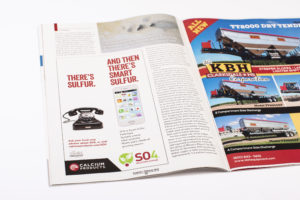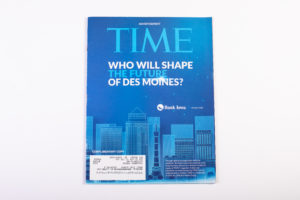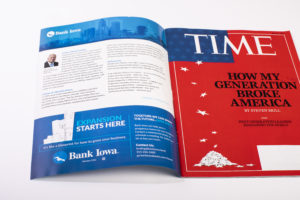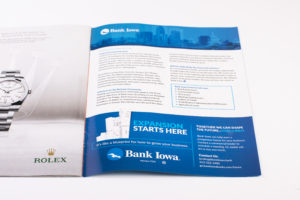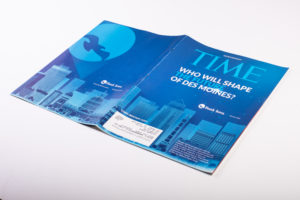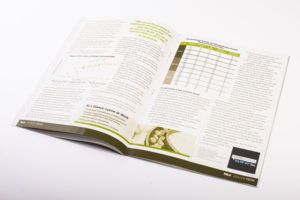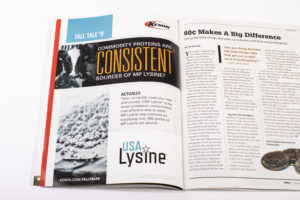A decade ago, media plans were pretty straightforward. The majority of the budget went to traditional media. Digital got whatever was left over (a measly 20%). Back then, digital advertising mostly meant clunky banner ads stuffed into e-newsletters and websites. Fast forward to now, and the game has completely changed. Digital media has exploded, becoming more fragmented and complex than ever. For B2B brands, the shift to digital has been impossible to ignore — and it’s time to learn how to improve paid media.
Just look at the numbers. In 2022, U.S. B2B digital ad spend hit $14.6 billion. That was a near 15% jump from the previous year. Things have only picked up since then. By 2026, spend is expected to climb past $23 billion.
TV advertising is feeling the shake-up, too. Connected TV (CTV) is now one of the fastest-growing ad channels, it was expected to hit $38.3 billion in ad revenue in 2024 with an expected 17.6% growth in 2025. Meanwhile, linear TV continues its slow decline, dropping from $60.5 billion in 2024 to a projected $56.8 billion by 2027.
And it’s not just brands making the shift. Viewers are too. A 2022 survey found that 57% of U.S. CTV users prefer ads on streaming platforms over traditional TV spots. Now it’s clear: Digital media isn’t an add-on anymore. It’s the main event. If your marketing strategy isn’t keeping up, you’re leaving opportunities (and revenue) on the table.
wondering how to improve paid media?
Here’s where things get tricky. Digital isn’t just growing. It’s evolving at a rapid pace. Platforms like Google, Meta, LinkedIn, and programmatic demand-side platforms (DSPs) all have unique ad targeting capabilities, algorithms, and reporting tools. And if you think you can just “set and forget” your paid media campaigns, well … yikes. That’s a recipe for wasted ad spend and disappointing KPIs.
To maximize your media dollars, you have to:
- Master each platform’s targeting features to make sure your ads are reaching the right people at the right time.
- Define clear KPIs (like click-through rates, conversions or return on ad spend ) and track them religiously.
- Measure success beyond vanity metrics. Impressions are cute, but are they driving leads and sales?
- Optimize constantly. Test different creative, tweak audience segments, adjust budgets and analyze performance data in real-time.
That’s a lot.
Yep, it really is. The days of throwing money at digital ads and hoping for the best are long gone. The brands winning in this space aren’t just investing in digital. They’re focused on what it takes to improve their paid media— refining, testing and optimizing every single dollar. Here’s how you can do the same.
Narrow in on your most useful channels and match them with budget allocations.
Choosing the right platforms for your ads isn’t as simple as picking the most popular ones. Each platform — be it social media, search engines, or display networks — has distinct strengths and audience demographics. Allocating your budget effectively means understanding where your target audience spends time and tailoring your strategy accordingly.
Take this as an example. Google ads might connect you with people actively searching for your products, but platforms like LinkedIn could be more effective for B2B targeting. Strategic budget allocation means placing financial resources where they’ll make the most impact across all digital marketing efforts, thus providing the best return. Budgets should align with overarching business goals and clearly defined marketing objectives so you can focus on better resource management and achieving measurable results.
Consider the make-or-break factor: Creative.
Even with a perfectly targeted media plan, subpar creative will have you throwing away money. A Nielsen study shows that 47% of a brand’s sales from advertising are driven by creative. In other words, compelling advertising that resonates with each audience segment is crucial. If your creative doesn’t hit the mark, you’ll have to spend significantly more to achieve the same results as a well-crafted ad.
Choose a seasoned partner to help manage it all.
When you’re looking into how to improve paid media, a team of trained professionals is a great option. Digital-first agencies live and breathe ad platforms, algorithm changes and emerging trends. They know how to stretch your budget and understand how to balance spend across channels. That means you don’t have to worry about over-investing in one area while missing key opportunities in another.
The right agency can also deliver killer creative designed to perform well in your chosen platforms and in front of your target audiences. Because you don’t just want your ads to be seen. You want them to get results.
Bottom line? Digital is the future, but only if you know how to work the system. Otherwise, you’re just burning budget while your audience scrolls right past. If you need some support to get there, the Lessing-Flynn team is here to help. We’re one of those digital-first agencies we mentioned. We can handle everything in-house, from attention-grabbing creative to audience targeting and online placements. All so we know our clients are getting the high-quality results they’re looking for. Get in touch.
Since the printing press was invented in 1436, media has been constantly evolving. Consumers have more and more places to go for entertainment and education. That should mean advertisers have more opportunities to reach target audiences. However, trendy strategies and a fractured media landscape can make it more difficult to get in front of the right people at the right time.
The funny thing? A saturated media landscape isn’t even a new problem for those who tackle paid media planning strategy. More than 100 years ago, Lessing-Flynn Founder Paul Lessing wrote, “Don’t try to use all the media in the world. They can start new publications faster than you can buy space in them.”
It’s a centuries-old problem that only gets more complicated each day. So, what can marketers do? Use our tips to help craft a timeless (trend-proof) media strategy.
![]()
Start with tried-and-true strategy
While the types of media placements have exploded, the basics of paid media planning strategy have remained largely the same over time. Marketers create media plans to put their brands (or clients) in front of target audiences. In these strategies, timing is essential. Planners use their in-depth industry knowledge to understand where audience members are in the buying cycle and what media placements can do to help move them closer to a purchase decision. Even with a solid strategy, this can be a long game for media planners. Different types of purchases will require more time for nurturing leads.
Professional planners know not every type of media needs be included and they don’t let trendy ideas distract them. Their strategies are focused on data and measurable results, helping move brands toward their goals. If a new ad technology fits the bill, great! If not, they won’t shoehorn it in just to say they did something innovative.
![]()
Keep an eye on trending topics
Now that we’ve covered the importance of a solid strategy, it’s time to examine why media trends matter. First, nearly all the advertising efforts we consider standard were trends at one time. Even newspaper ads were a novelty once (though it’s been a while).
Some tactics currently considered trendy could end up as a staple in your future paid media planning strategy. Just take the conversation around third-party cookies. If you weren’t paying attention the last few years, you might not have noticed that they’ve essentially come and gone (since Google is the only major browser still leveraging them). You certainly wouldn’t have been taking steps to implement cookie-less targeting—leaving you several steps behind the competition.
Being trendy doesn’t make a tactic inherently good or bad. And you can certainly try new things. Just don’t drop your carefully curated plans for what everyone else is doing.
![]()
Understand the inner workings of new marketing technology
By now, it’s clear that ad tech companies offer plenty of options for paid media. Understanding the mechanics of different technologies will help you understand how you might leverage them to work for you.
Take weather-triggered ads for example. At first glance, a weather-dependent ad experience seems like it’s limited to consumer products like clothing or food (think: winter coats during a cold snap or ice cream during a heat wave). But knowing what the technology can really do — trigger targeted ad placements based on local weather events — allowed the Lessing-Flynn team to push agricultural equipment made to speed up forage drying after rain.
Rather than follow the crowd and throw your budget at the latest and greatest tech, take the time to find whether there’s a fit for your brand.
![]()
Consider how measurable your efforts are
Within the huge availability of both digital and traditional media placements, your ability to track results will vary. Naturally, digital options lend themselves to measurement. For many marketers, that ability to track conversions and optimize campaigns is enticing. But that doesn’t mean traditional tactics — like billboards or linear (non-streaming) TV — aren’t valuable. It all depends your brand and your goals.
The same applies to new trends and technologies. If you’re ready to try something new, think about whether you want something you can directly measure or if you’re willing to try a tactic that’s less closely tied to results.
![]()
One last thing…
An important thing to note about paid media planning strategy: There’s no one right way. If you had two experienced media planners craft a strategy for the same client, you’d probably get different results. And yet, both approaches would have merit.
If you’re looking for a sign it’s time to try something new, this could be it. And if you think it’s time to call in the experts, Lessing-Flynn is here for you. Get in touch to talk media strategy.
TapClicks — an all-in-one marketing analytics platform — featured Lessing-Flynn in a case study about tracking, analyzing and acting on data in a way that helps us provide value to our clients. Here’s a sneak peek; you can read the full TapClicks case study here.
Marketing analytics problems:
Prior to TapClicks, we at Lessing-Flynn relied on Excel spreadsheets for our marketing analytics and reporting. Anyone who works regularly in Excel knows that formulas can break quite frequently. This leads to unnecessary errors and valuable productivity lost in your day. We would have to review data from multiple sources then manually enter each piece of information into a spreadsheet. This was extremely tedious and took away from analyzing the information to help find optimization strategies.
TapClicks solutions:
TapClicks created a custom dashboard that automatically pulls data from Google Analytics and a wide range of other sources. This eliminated the need to manually enter each piece of data into one spreadsheet. We’re also able to pull publisher media we purchase, trade show activity, and other traditional tactics into comprehensive client reports. Additionally, our clients can now log into the TapClicks dashboard on their own to review the data themselves. Data can be manipulated for specific date ranges to aid in client use for their own reporting needs.
“TapClicks has enabled us to be much more efficient with our time and resources and quickly reference results from past campaigns, which has helped us create smarter marketing strategies,” said Shannon Hughes, director of digital and media strategy at Lessing-Flynn. “We now no longer have to rely on spreadsheets for our reports, helping us spend less time on analytics each month and share data with our clients in a visual way.”
Stellar results:
TapClicks has expanded our capabilities to include vertical and overall benchmarking for our clients. This has instilled both assurance and validation in our approach, and translating into higher client confidence and retention. By reviewing data across clients within TapClicks, we’re able to gain valuable insights into the market, repurpose this data, and provide a competitive edge for our team.
If you’re interested in leveraging Lessing-Flynn’s marketing analytics dashboard, contact our team today to see how we can partner to get you the data your business deserves.
Whether your company is big or small, seeing a return from your advertising dollars has always been a huge deciding factor on ad strategy. With that being said, have you ever considered investing in YouTube in-stream ads (formerly known as pre-roll ads)? Don’t even know what that is? That’s ok! We can break it down, and tell you the top five reasons they’re cool as hell.
So you’re about to watch a YouTube video, and an unsolicited clip starts playing before you can watch what you want to watch. Right now, you’re probably thinking: Oh that’s what an in-stream ad is? It’s that annoying thing standing between me and my funny cat video compilation? Yes. That’s exactly what it is. But here’s why forcing people to view your ad is actually an awesome idea.
5 reasons to consider YouTube in-stream ads
1. Short, sweet and to the point.
YouTube in-stream ads have a few nifty options to choose from. If your video is longer than 15 seconds, viewers will have the option to hit a skip button after three seconds to move on to their video. While unskippable pre-roll videos have a reputation as being “annoying,” the fact is that they reach consumers in a way they literally cannot ignore. That says a lot.
Convince & Convert notes that pre-roll ads function well at the top of the funnel. Like TV and radio ads, they will raise consumer awareness of the product. Through targeted advertising (we’ll get there next), these users can be converted into customers.
2. Target your people.
Pairing your pre-roll ads with your desired audience will get you the most bang for your buck. Let’s say you’re marketing a local hardware store. Adding pre-roll ads to do-it-yourself home renovation videos that are delivered to viewers located within a specific area code will ensure that your message is reaching consumers who will find it very relevant. Similarly, if you’re marketing a nationally sold brand of tools, you can target all YouTube users and put pre-roll advertisements on “viral” DIY videos that need tools to complete the projects in order to attract high levels of interest.
3. All the traffic. Just all of it!
- YouTube is the second largest search engine and the third most visited website worldwide — behind Google and Facebook, respectively (no surprises there).
- 1 billion people visit YouTube each month globally.
- 100 hours of video are uploaded every 60 seconds to YouTube.
- According to Nielsen, YouTube reaches more U.S. adults aged 18 to 34 than any cable network.
- YouTube is bigger than Bing, Yahoo, Ask and AOL combined.
4. Big budget, little budget? Not a problem.
Without considering the cost of creating your video ad, the actual placement budget can range in accordance to how much you want to spend. You pay when a viewer watches 30 seconds of your video (or the duration if it’s shorter than 30 seconds) or engages with your video, whichever comes first. While we unfortunately do not have a pricing chart available, Google AdWords can help you determine the budget by making a backward calculation.
First decide the amount of views you would expect from advertising. Then make a drafted campaign for AdWords for video. Select the targeting criteria and see how many views the estimation graph is showing based on those targeting and other campaign settings. This may not be the accurate way to determine the final price, but it is an effective way to get an estimate of how much to spend for the number of views you expect.
5. Guaranteed analytics.
It’s always nice to be able to track results. With analytic tracking provided by Google AdWords, you will have access to all the numbers your heart desires. Views, impressions, earned views, click-thru rates — you name it, and there’s a column and corresponding chart to help you see just how your ad is performing with viewers.
Want to continue the conversation about YouTube in-stream ads? Contact our digital and media communications team — we would love to chat!
Originally published March 8, 2016
Types of media advertising, or as Lessing-Flynn (LF) often refers to it, media placement types, continue to grow in variety and scale as people absorb more and more media on an array of platforms. But what are all of these types of media advertising and how do you create a media mix that drives brand awareness, recall and most importantly a desired action or conversion?
While it is important to be able to identify these different advertising placement types, understanding how people are consuming media today is step one. Before I throw a bunch of stats at you, let’s call out the obvious! As we progressed through 2020, it changed the way people look for and consume content. 82% of U.S. consumers are regularly spending more time with at least one device since the beginning of COVID-19. When the world shut down, anything and everything digital went WAY up. Here is the proof.
- Traditional print media ad spend peaked before the financial crisis in 2008/2009 but has hit new lows not seen since the mid 1980’s.
- Radio has remained semi-flat since the early 2000’s.
- Traditional TV spend matches the investment after the financial crisis.
- Digital advertising types are anticipated to continue growing and account for over 70% of paid media spend by 2024.
- CTV ad spend was anticipated to grow more than 25% in 2020 and digital video by 11%.
- Programmatic ad buys were expected to increase by 6%, while non-programmatic was projected to increase by only 2%, showing the powerful shift to programmatic.
The marketing funnel
The marketing funnel shown below is often one of the first chapters in a marketing 101 book. Why? Because you can tie almost any product or service consumption to following these steps. Granted, there are some that are missed in the cycle, or some funnels that use different terms – but either way, this is a good staple to tie ad placement types too. As we walk through the different types of media advertising, you will notice we have mapped them to different levels in the funnel. This is a great tool to help ensure, as you are promoting your products/services, you are not leaving all the work at the top of the funnel. Your paid media investment is working to draw people down and through it. It then becomes the company’s job to build customer advocacy.
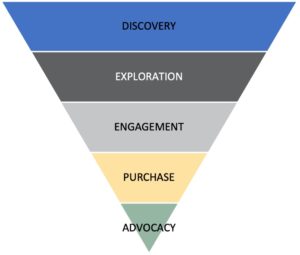
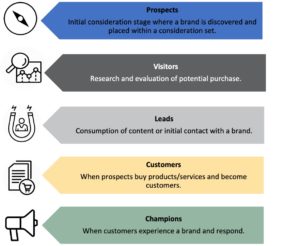
Types of media advertising
Connected TV (CTV)
Traditional TV spot style purchasing through the use of Smart TVs and streaming devices that are attached to TVs. Audience targeting is layered outside of typical programming or station targeting. Mobile and desktop devices are not included under the term CTV.
- Funnel placement: Discovery
- KPI: Impressions
High-impact
Animated or static ads that are typically used to capture a user’s attention before navigating through the rest of a website. These ads are oftentimes bigger or intrusive.
- Funnel placement: Discovery
- KPI: CTR or action available within ad unit (ex. video view-rate)
E-newsletters
An ad shown within an e-newsletter.
- Funnel placement: Discovery
- KPI: CTR and website sessions
Out-of-home
An advertising tactic aimed at reaching a consumer on the go by targeting them outside of their homes. Billboards are typically known as the most common tactic of out-of-home advertising.
- Funnel placement: Discovery
- KPI: Impressions
Over-the-top (OTT)
Streaming media service (ex. Hulu) offered directly to viewers via the Internet. OTT bypasses cable, broadcast, and satellite television platforms, the companies that traditionally act as a controller or distributor of such content.
- Funnel placement: Discovery
- KPI: Impressions
Video pre-roll / in-stream video
A sponsored video that appears before or during the video an individual is viewing. May be skippable or mandatory viewing.
- Funnel placement: Discovery
- KPI: Views and view-rate
Radio
The buying of radio commercials, frequently called spots, to promote a client’s products or services. Most commonly purchased in 15-, 30- or 60-second increments.
- Funnel placement: Discovery
- KPI: Impressions
Streaming audio
Audio ads that are run on websites, apps and platforms used to stream radio, podcasts and other forms of audio. Oftentimes in the form of 15-, 30- or 60-second spots and accompanied with a display ad.
- Funnel placement: Discovery
- KPI: Listens and listen-rate
Television
The buying of TV commercials, frequently called spots, to promote a client’s products or services. Most commonly purchased in 30-second increments.
- Funnel placement: Discovery
- KPI: Impressions
Social
Advertising focused on social networking sites, like Facebook, in which advertisers can use a variety of targeting options to ensure their ads are reaching an appropriate audience.
- Funnel placement: Discovery and/or exploration
- KPI: Dependent on ad type. Refer to variety of ad type KPI’s above and below.
Run of site / run of network (ROS/RON)
Display ads that run across an entire website (run of site) or network (run of network), meaning they could appear on any page within that site or network of sites.
- Funnel placement: Discovery
- When implemented as a retargeting tactic it hits the engagement level of the funnel.
- KPI: Impressions and website sessions
E-blast
An HTML message sent via email on behalf of the advertiser.
- Funnel placement: Discovery or engagement
- KPI: Open-rate and CTR
- Stretch goal: Leads
Native
A content-based ad that mimics its environment. Can include images, headlines, shortened teasers or fully hosted articles.
- Funnel placement: Exploration
- KPI: Time on targeted content page
Search text ads
Ads that are charged upon that click and serves said ad in search-engine results whenever someone searches for the services or products offered by the advertiser.
- Funnel placement: Exploration
- KPI: CTR, website sessions and pages per session
Targeted custom message
A form of communication, whether it be via email or text message, where the advertiser can interact one on one with their intended audience. Targeted custom messages typically use publisher data to reach the most accurate
consumer.
- Funnel placement: Exploration
- KPI: Impressions
Text message
A text-based ad sent directly to an individual’s phone number from an advertiser. These are to be distributed as one of the following:
Multimedia message service (MMS): Text with accompanying video or image.
Rich communication service (RCS): Interactive communication similar to bot-style messaging.
Short message service (SMS): Text only.
- Funnel placement: Engagement
- KPI: Clicks (or other action dependent on ask/assets)
Now that you have the foundation of the various types of media advertising and how they relate back to the marketing funnel, check out a few more of our blogs that give great tips on implementing these media placement types into your annual media plan.
- How to make print media advertising powerful on a tight budget
- Digital ad services: Making the move from traditional to digital
- OTT advertising: How to make media over the top
Sources:
- eMarketer
- Visual Capitalist
- Global Web Index
Print ads are not dead
Every year, when media planning season ramps up and the upcoming year’s goals are outlined, I hear: “Let’s reduce our print media advertising budget. I’d like to see a heavier digital approach.” Which opens the door to my follow-up question: “Why?”
Straight from the media buying trenches
Clients are becoming more risk-averse with digital media. As media budgets have gotten tighter (or remained flat), the desire to reach a larger audience at a higher frequency through digital advertising just makes sense — it’s economical. Plus, with great reporting, digital tells a great story. Not only can we tell you the reach and engagement, but if we use UTM codes, we can tell you what individuals are doing past the click.
This migrates the success of the media strategy away from the last click attribution model and tells the story of brand engagement before action. And let’s face it, QR codes are dead and everyone is avoiding your unique URL, which are standard ways brands try and judge the success of print media advertising. Potential customers are going straight to Google to search for you, which can skew ROI calculations.
>> Also read: “Making the Move to Digital Advertising“
The print audience is still there
“It sounds like I’m correct to want a heavy digital approach, Shannon. Where are you going with this?” — All of you.
Not so fast.
We all know print media advertising is more expensive. Not only are you paying for a specific audience, but you are paying for the printing cost and the contextual editorial relevancy to your product or service. But for many of our clients, print ads still come out as the number one medium consumed in their industry. So, while it can be more expensive, the audience is still there and still consuming.
“At Meredith Agrimedia, we continually invest in research and insights. Ag magazines rank as the highest form of media consumption for farmers. In our 2017 Farmers’ Use of Media study, we saw that 99 percent of the farmers who responded utilize ag magazines as an information source for agricultural products or services.” — Tyler Smith (Meredith Agrimedia)
Print media advertising is brand awareness advertising
Print ads in their most basic form are used as a brand awareness tactic and have been since the 1700s. Because all advertising requires a healthy frequency to elicit brand awareness (industry average is about three-to-four times) print becomes more expensive at a rapid rate. But if your audience is there, why should you care?
“While there are many options for media placements, print ads can still move the needle. This has been confirmed time and time again whenever research is released about media consumption in the ag sector, regardless of age. The ag industry is very hands-on and tactile in nature, so it’s only natural that ag audiences often prefer getting information from things they can physically hold like print publications.” — Leah Mindemann (Farm Journal)
Digital may be on the rise, but print is staying steady. Consumers are now consulting multiple forms of media to make informed buying decisions. Even if you don’t agree that print ads still hold great value, abandoning one channel in favor of the other should be done slowly and tested so your audience doesn’t think you ghosted them. Additionally, the mix of mediums can be determined by the goal of your media and your expected outcomes.
Let’s revisit your media budget
Your media buyer will (and should) help you establish your intended audience goals. Below are some approaches and tactics we have executed to make the most of print media advertising dollars — many of these have been placed in favor of a standard frequency print buy.
1. Still present, print ad approach
If you are used to doing full page print ads but foresee a budget reduction, look into half page islands (standard size magazines) and junior pages (tabloid sized publications). These reduce your ad size but allow text from editorial to wrap around it. Additionally, these are typically slated toward the front of the book and are not surrounding or stacked with other advertisers.
2. Demonstrating thought leadership
If you already produce great content and invest in native digital advertising, advertorials are coming back in style. It’s the old-school version of native advertising. These are written and laid out by the advertiser and can be purchased in different standard ad unit sizes.
Additionally, you should consider partner pieces with your publisher. They pair an editor and an advertiser industry expert to write a piece. These can be editorial only or can be paired with ads to make a feature section. Because the publisher manages the design and layout, and it’s written by one of their editors these pieces come with the added credibility and authority of the editor.
3. Announcements/promotions
Launching a new product or have a killer promotion coming up? Consider hitting your audience with a bellyband, a custom cover wrap or a front cover barn door. Consider inserts and tangible coupon offers that customers can directly redeem. Use custom coupon codes to count redemptions and track them by location. Because these tactics are higher impact, you can get away with a one-time frequency that elicits awareness and action. While the price up-front is steeper, it is usually more cost effective than a standard print frequency buy and often times drives a desired action outside of brand awareness.
You’ve got this — don’t let me down
Today there are an unlimited number of ways to reach an audience (or even an individual) with your message. Doing it in the most effective way is the trick. Hiring an expert to sort through and vet all of the options can be well worth it and will lead to a better return on your media investment. Be sure to contact Lessing-Flynn if you ever need help with strategic media buying decisions.
Print examples
Originally posted March 26, 2019
Media consumption habits, specifically over-the-top OTT advertising habits, have changed for the long haul, all thanks to the current global pandemic. In fact, 92% of Americans say they are spending more time on in-home media activities. More so — 86% of American consumers share they are spending more time using at least one digital device since the start of the outbreak. And if those stats don’t grab ya, here are a few more:
- 44% of U.S. consumers report they are watching more shows/films on streaming services while at home because of the COVID-19 outbreak.
- 33% say they are watching more videos (e.g. on YouTube) due to stay-at-home orders.
- Prior major crises that caused U.S. consumers to stay home resulted in a 61% increase in streaming. While home during past crises, people most often tuned in to news, general-format programming and feature films.
- 29% of U.S. consumers report using their smart TV/media streaming devices more during this time. 11% of U.S. consumers say they are spending more on streaming subscriptions than they typically would.
- Streaming apps are becoming more popular. Nearly 50% of U.S. consumers have added a free streaming service since the beginning of 2020. Another 20% of U.S. consumers have subscribed to a paid streaming service due to COVID-19.
- 35% of U.S. consumers say Netflix is the streaming service they have watched most during quarantine, compared to 10% for Hulu and 9% for Amazon Prime Video.
Considering OTT advertising for your brand
The increase in streaming TV/video consumption habits is not expected to change any time soon. Should your brand consider investing in advertising in this space?
First, you’ll want to understand what OTT advertising is. Many folks use this term synonymously with connected TV (CTV). While they are related, they are not twins. While it uses similar targeting mechanisms, OTT refers to video advertising only. See below for a break down of these definitions and more.
OTT
OTT is a streaming media service (ex. Hulu or Sling) offered directly to viewers via the internet. OTT bypasses cable, broadcast and satellite television platforms, the companies that traditionally act as a controller or distributor of such content.
CTV
CTV is the purchase of traditional TV-spot-style placements through the use of smart TVs and streaming devices that are attached to TVs. Audience targeting can be layered in outside of typical programming or station targeting. Mobile and desktop devices are not included under the term CTV.
Streaming audio
Audio ads are run on websites, apps and platforms to stream radio, podcasts and other forms of audio. They’re oftentimes in the form of 15-second, 30-second or 60-second spots and accompanied with a display ad.
Audience targeting for OTT advertising
Since OTT can be streamed on your phone, tablet or smart TV/streaming device, your options to reach your target audience are broad. The technology roots itself in the basic principles of programmatic ad buying and serving. This focuses on the person, not the place. The most common targeting options for OTT advertising include your standard parameters, such as location, TV/video content and device, as well as broad demographic data, such as gender, age, etc. While these are all great, they don’t overly differ from purchasing standard broadcast TV. The icing on the OTT advertising cake lies in the introduction and layering of first- and third-party data and look-alike modeling based on conversion goals.
How targeting breaks down:
- First-party data is the information you collect directly from your audience; examples include:
- Data from actions, interests, behaviors, etc. across your website or app
- CRM data
- Surveys
- Subscriptions
- Social
- Third-party data is purchased and layered in from other or outside sources. Data can be purchased (private) or pulled (public) by large data companies. These data companies aggregate the data into one large data set and sell it as third-party data. (Yes, I said data seven times!)
- Conversion goals are measured by pixels placed across your website to attribute campaign success to measurable action. Examples include form completions, click-to-calls, etc.
- Note: These are harder to implement on OTT advertising campaigns as many do not offer a click option. OTT’s primary goal should be reach, frequency and product/brand awareness or lift.
- Purchase CTV the same way. Just keep in mind it is served through smart TV and TV streaming services only. CTV makes more assumptions about who you are and relies on your IP address to associate said targeting methods.
Ok, so now that we are speaking the same language…how do you go about adding OTT advertising to your media buy? The answer is easy — give Lessing-Flynn a call.
Sources: Global Web Index, Centro, iHeart Media, Neilsen
Oftentimes when people think of digital ads, they default straight to Google Ads. But there are many instances when the targeting and placement opportunities on Facebook are just as relevant, if not more so. Facebook Ads can do so much more than just boosting your posts (and no, I don’t mean influencing presidential elections). So, let’s break down the different targeting and placements opportunities of each platform and go over guidelines on when to use each.
Targeting:
| Keywords | X | ||
| Geography | X | X | |
| Demographics | X | X | |
| Interests | X | X | |
| Education / work | X | ||
| Life Events | X | ||
| Parental status | X | X | |
| Behaviors (ex. technology early adopter) | X | ||
| Event attendance | X | ||
| Prior engagement | X | ||
| Website visits | X (with Pixel installed) | X (with Pixel installed) | |
| Custom audience | X (on select placement types) | X | |
| Lookalike audience | X | ||
| Affinity audience | X | ||
| In-market audience | X |
Digital ad placements + types:
Google Ads
Google Ads come in many different formats, with different targeting methods available to each. Based on the ad type selected, the ad creative can include text, banner, video and Gmail ads.
- Search ads
- Display ads
- YouTube ads
- Gmail ads
Facebook Ads
All Facebook Ads allow graphics/video with a link or a lead form no matter the placement.
- Facebook News Feed
- Facebook Stories
- Facebook Messenger
- Instagram Feed
- Instagram Stories
- Facebook Instant Articles
- And more! Facebook has a handful of additional placement types, but the above are the most frequently used.
A note if you’re a B2B business: Your contacts and prospects are people too! Facebook isn’t just for B2C brands. It is actually a great tool to use for B2B advertising as well. With the target capabilities, you’re able to hone in on your audience and reach them wherever they are: at work or at home.
When to use Google Ads:
- To be top-of-mind when someone is searching the market for a product, Google text ads are the way to go. Because a user is actively searching for a product, brand or solution, your ad has the opportunity to be shown at the exact moment they need it!
- Wide brand awareness can be achieved with Google display ads by reaching your audience on websites that may be related or unrelated to your business.
- If you have a video that you want more eyes on, Google Ads is the answer. The YouTube ad offerings for Google Ads are far more comprehensive than Facebook video ads. Although, Facebook is starting to dip their toes into the in-stream waters and expand their video ad opportunities. Keep an eye out.
- Custom emails can be an effective tool, but expensive. Gmail is a great way to get a larger message right into the email inboxes of your target audience. The format of emails can resemble a custom eBlast, but you can rely on ad targeting instead of a publisher’s database too.
When to use Facebook Ads:
- Think about the last conference you attended. How often did you scroll through Facebook between sessions or send your family a quick Facebook message? There is a great opportunity to combine detailed targeting (including by industry, job title, etc.) with geography to reach the right audience while they’re still at your event.
- If your main goal is to generate leads, Facebook is the place to go! With their integrated lead generation form, a prospect never has to leave the app to share their information with you. Plus, your team doesn’t have to design and build a conversion-optimized landing page.
- Complex creative messages can perform well on Facebook as there are plenty of opportunities to showcase copy and images separately.
- Thought leadership content is ripe for distribution via Facebook Ads. Whether it’s a new whitepaper download or a thoughtful blog post, you can directly offer that content up to a relevant audience and inspire clicks or downloads.
Why you should consider using both:
- We’ve all been a victim of Amazon’s retargeting ads when we place something in our carts but don’t check out — then it pops up on the side of your screens for weeks. There is a great opportunity to channel this energy using Google Analytics or Google Ads tags and the Facebook Pixel to reach past website visitors with a conversion message. This is an especially great tactic because the user has already shown interest in your brand by visiting your website.
- Both platforms can prioritize clicks to gain website traffic for your brand. This is especially true if you are advertising a specific product type that people may be searching for.
- If the goal is general brand awareness, you can combine Facebook Ads with Google display ads to reach a wide-spread audience.
At the end of the day, there is a time and place for both platforms. But they are both important to a comprehensive media plan and can play a vital role in meeting your organization’s KPIs. Don’t be afraid to dip your toes in the digital advertising waters — you’ll see there are plenty of opportunities!
For many, this time of year includes holiday decorating, caroling, hot cocoa and roasting chestnuts by the fire. For those of us in the world of paid media, this time of year brings spreadsheets, more spreadsheets, budgets and most importantly, strategic media planning. And, did I mention lots of caffeine? At Lessing-Flynn, we take a different approach to media planning. While we won’t share our secret recipe, we will provide a few of the ingredients.
- The “Mix”: All good recipes start with the right mix of ingredients. A media plan is no different. Buying one tactic or media placement all year long and expecting it to effectively hit all your key performance indicators (KPIs) is a dated, ineffective practice. For this reason, having a healthy mix of media placements that fit your different KPIs will help you achieve multiple goals and later allow you to better measure and evaluate the success of your media plan.
- Everyone Is a “Regular” Consumer: Reaching your target audience when, where and how they consume media seems self-explanatory, right? Many people forget, when advertising in the B2B space, that these individuals are regular consumers as well. Think about how you consume media. Often, we are on the couch watching TV while on our laptops or phones while magazines and other media products surround us. By including a multi-touch-point model, you are sure to keep your brand in front of your audience — even when they may not be thinking about your product.
- Brand Awareness Ads Don’t & Shouldn’t Sell Products: Many times, it is easy to assume that the second someone sees your ad, they are going to go out and buy your product. This is what many refer to as “last-click attribution.” While this may work on products with a low barrier to entry — a whitening toothpaste, for example — this too is a dated digital misconception. Even with the whitening toothpaste, it is not likely someone will see a banner ad, click it and purchase the product at that moment. The consumer is more likely to consider it when they run low on toothpaste at home and purchase it at the store, meaning you cannot correlate someone seeing your ad to purchasing the product. Therefore, using display banner ad campaigns, print ads and other brand awareness tactics to tie to high barrier-to-entry sales is a no, no.
- Data: Use It Well & Use It Wisely. Now more than ever, data on the performance of your paid media tactics is right at our fingertips. So why not use this information? Whether it is direct performance of your client’s previous placements, publisher studies, third-party studies or other client successes, USE the information you have. Digital media has more targeting capabilities than ever — using a mix of publisher/industry data along with the client’s previous placement success should mean you have a media plan with limited waste and high performance.
- Stir & Taste! No recipe has ever called for you to put the ingredients in the bowl and leave them there. You have to stir, taste and tweak! The same goes for a media plan. Give your media plan time to work its magic; give the ingredients time to mix and marinate together. And, if your recipe yields a foul-tasting dish, ditch it and try again: With a media plan, it is ok if a placement or two didn’t work out. Just remember that and don’t try it again. And of course, tweak the recipe to make it better. Take out what isn’t working and reallocate the budget to what is. Optimization is the key to making your media plan and investment work harder for you.
The Lessing-Flynn Marketing Mythbusters are a crew of crafty marketers ready to bust a cap on the myths that are mucking up your brand. Today, we’re taking on native advertising. This term is thrown around frequently these days, but do you know what it really means? No sweat — marketing mythbuster and Media Specialist Shannon Hughes is here to clarify the difference between native advertising and content marketing.
Where does print fit in the 21st century? Sooner, not later, it needs to radically re-invent itself to remain relevant as a primary play in the media mix or, at the very least, as a much needed income source for publishers.
To date, most of the changes so far have focused on reducing operating costs and downsizing editorial product, while discounting rates on what has increasingly become much more valuable – digital content – simply to shore up a print buy. That seems to be a short-term, short-sighted solution. It certainly won’t save publishing’s sacred cow.
Which brings me to some of the questions media buyers are asking today: Why continue to buy print if editorial continues to report on the news that happened weeks ago? Why does controlled circulation even make sense if readers don’t see enough value in a magazine or newspaper to pick it up and read it? No matter what BPAs claim? No matter what the demographics show? Do readership studies provided by publications truly reflect what’s happening out there? Those reports are becoming harder and harder to believe and defend. Why? Just ask yourself this question: When was the last time you thoroughly read the print version of a trade publication when the digital edition had already been released?
Where do we go from here? In my opinion, publications need to fundamentally change their editorial product. We’re finally starting to see evidence of it now, although the pace is glacial. For example, is it possible to create and sustain a highly prized weekly intelligence report with thought-provoking and engaging content? Content that doesn’t rely solely on advertising? Content that attracts readers willing to pay for better information? Information that is critical to their needs and success? Will readers be willing to pay? Or, is there some other hybrid solution out there? Those publishers who are digging deeper and pounding the streets more for relevant and impactful content will be the winners.
By the way, if you haven’t aggressively ramped up your digital media allocation this past decade, you’re either totally out of touch with what’s happening, or in total denial!
Where do we go from here? Share your thoughts with us on Facebook and Twitter.
As a long-time strategic planner and hands-on buyer of print media, for a wide range of B2B and Ag clients, Connor Flynn has witnessed not just the progression of media buying, but also the evolution of the print media industry – from general interest consumer and trade magazines used in the days of mass media to the consumer-driven messaging and analytics of digital and social networking. Here’s a unique perspective from one who has lived it during the past 45+ years.
There used to be a time when the publisher’s rate card ruled all pricing for ad placement (and when media kits were some of the most spectacular and ornate pieces of collateral in advertising.) Today, for all practical purposes, these two tools of the trade are dead. Thank goodness!
There used to be a day when the barrier separating advertising infringement and editorial integrity was sacrosanct, and when publishers and editors/reporters controlled content. Today, more and more content is provided by a wide and diverse contingent of marketer advocates. And now we’re getting much of our news and information from experts who are closely aligned or contractually compensated by marketers who help sponsor their work. In some ways, this has helped fill a major void in B2B and Ag editorial.
A lot has changed. And I’m sure some die-hards still yearn for those SRDS-days of old. And yet, when you look at the bigger picture, many of these changes have actually opened doors and, in some ways, have improved the product publishers deliver.
Am I advocating the use of spin doctors to be valued resources for content? No way! Am I predicting the end of print media? No, not in my lifetime. The control and future of print remains to be squarely in the hands of today’s leading publishers based on the quality of the content they provide. However, changes so far have merely delayed the inevitable.
Look at what’s happened during the past three decades. In many B2B markets, (and especially in agriculture) consolidation and mergers drastically reduced the revenue pool. The battle for fewer media dollars forced rates to plummet. Then, one by one, publishers went from paid circulation to controlled and eventually abandoned their published rates. As a result, editorial staffs and circulation were cut. And now we have a continuous onslaught of digital and social media options, and a greater demand for accountability (which print can’t truly quantify.) Print is also harder to access and inherently late, because today’s news and information is digital, immediate, mobile and more intuitive.
Where does print fit in the 21st century? Read Part Two, and share your thoughts with us on our Facebook or Twitter.
As a long-time strategic planner and hands-on buyer of print media for a wide range of B2B and Ag clients, Connor Flynn has witnessed not just the progression of media buying, but also the evolution of the print media industry – from general interest consumer and trade magazines used in the days of mass media to the consumer-driven messaging and analytics of digital and social networking. Here’s a unique perspective from one who has lived it during the past 45+ years.
